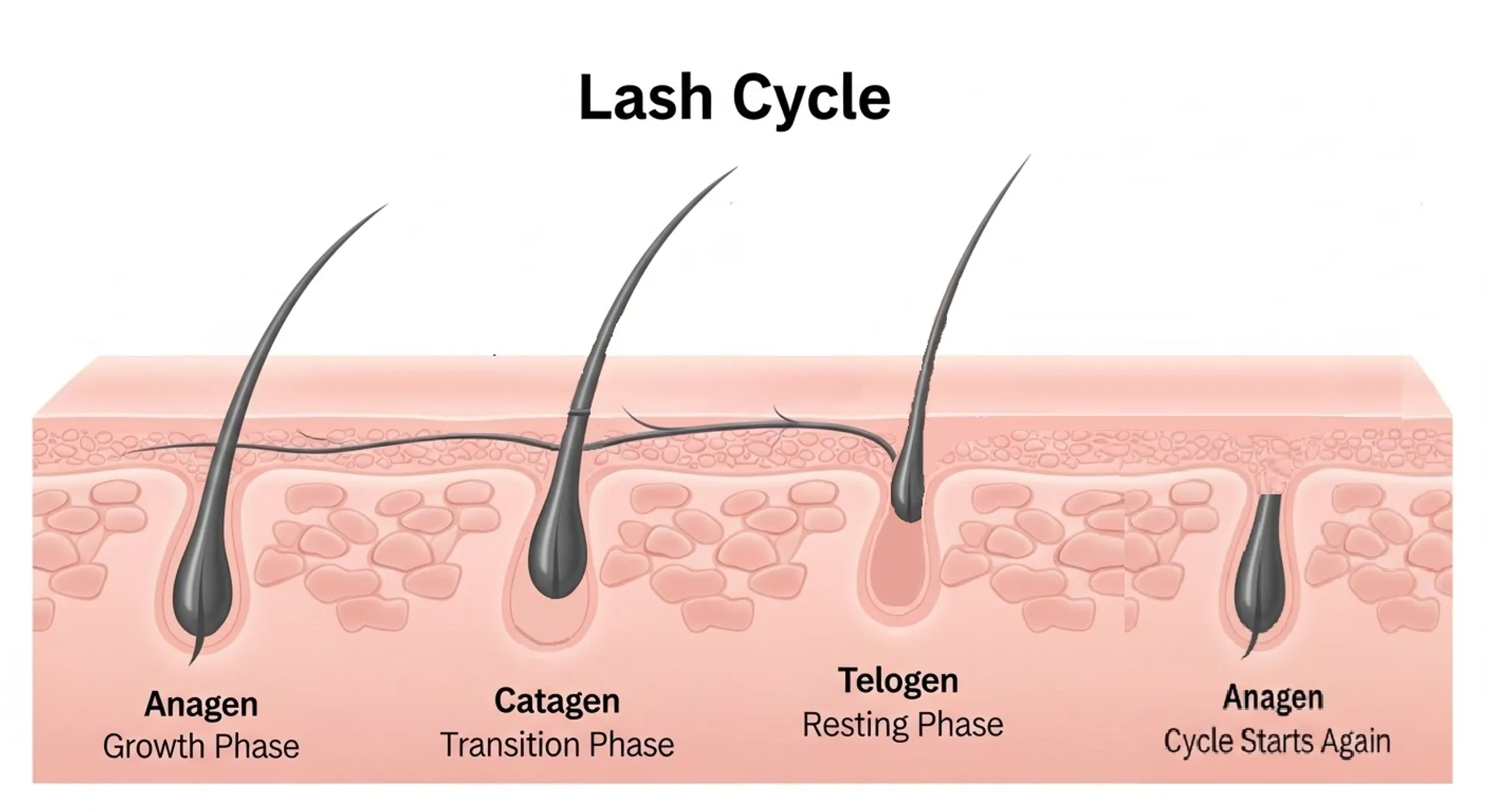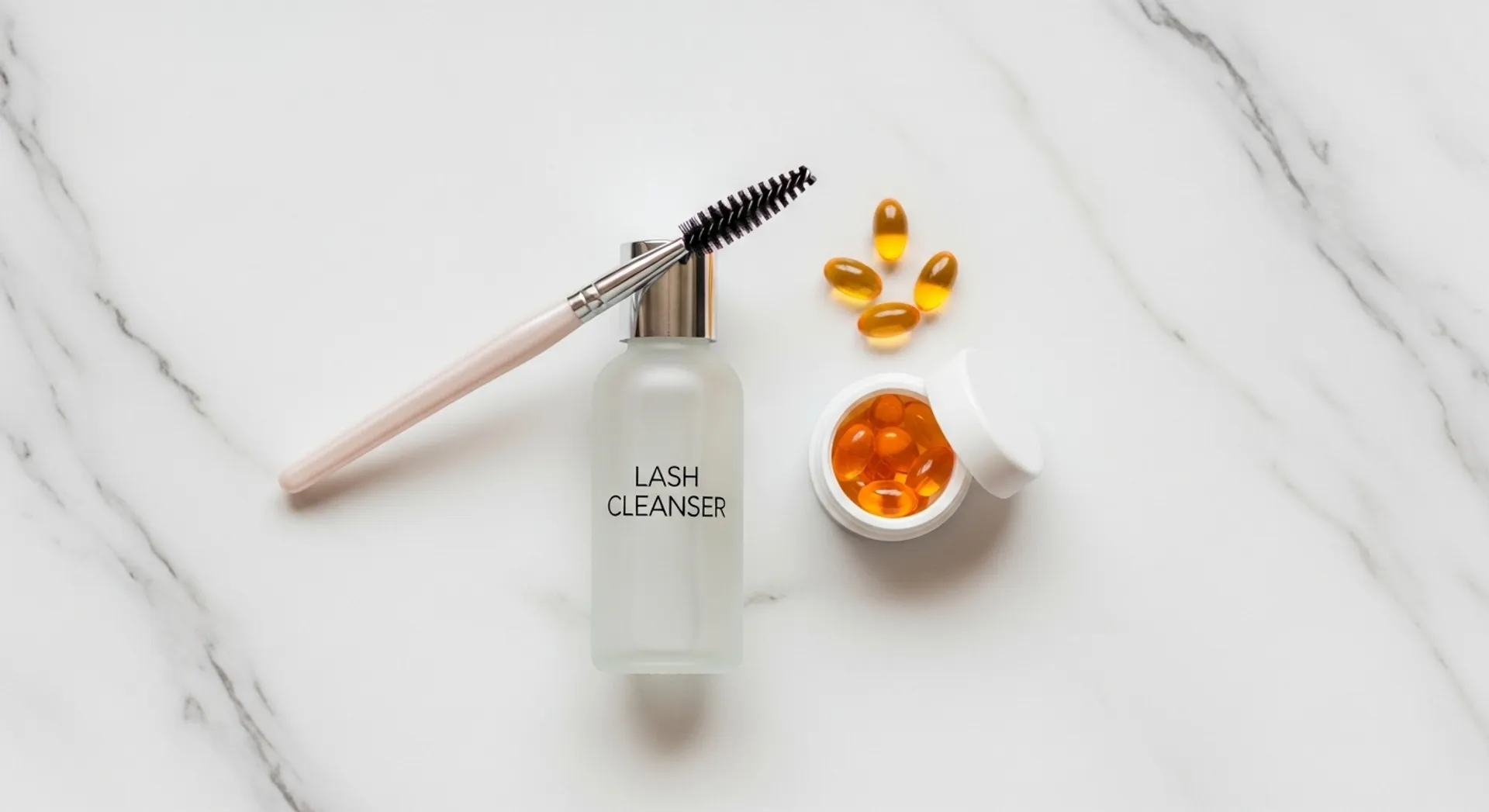If you’ve ever wondered why your lash extensions seem to shed at different rates or why your lash artist recommends fills every few weeks, the answer lies in understanding the natural lash growth cycle. Just like the hair on your head, your eyelashes go through a continuous cycle of growth, rest, and shedding. This biological process is completely normal and affects how long your lash extensions last and when you should schedule your next appointment.
The Three Phases of the Lash Growth Cycle
Your natural lashes follow a specific growth pattern that consists of three distinct phases. Each individual lash is at a different stage of this cycle at any given time, which is why you don’t lose all your lashes at once. Understanding these phases helps explain why lash extensions shed and why regular maintenance is essential for keeping your lash line looking full and beautiful.
Anagen Phase: The Growth Stage
The anagen phase is the active growth period where your lash follicle produces a new lash. This phase typically lasts between 30 to 45 days, though it can vary from person to person. During this time, the lash grows approximately 0.12 to 0.14 millimeters per day. Only about 40% of your upper lashes and 15% of your lower lashes are in this growth phase at any given time. This is the ideal stage for lash extension application because the natural lash is strong and firmly anchored in the follicle.
Catagen Phase: The Transition Stage
Following the growth phase, your lash enters the catagen phase, which is a brief transitional period lasting about 2 to 3 weeks. During this stage, the lash stops growing and the hair follicle begins to shrink. The lash detaches from the blood supply and becomes what’s known as a “club hair.” If a lash falls out during this phase, the follicle must complete this transition before a new lash can begin growing. Approximately 3% of your lashes are in this phase at any time.
Telogen Phase: The Resting and Shedding Stage
The telogen phase is the resting period that can last anywhere from 4 to 9 months. During this extended phase, the old lash remains in the follicle while a new lash begins to grow underneath it. Eventually, the old lash is pushed out by the new lash growing in, completing the cycle. More than half of your natural lashes are in this resting phase at any given moment, which is why natural lash shedding is constant and normal.
Why Your Lash Extensions Shed Naturally
One of the most common concerns among lash extension clients is shedding, but this is actually a sign that everything is working as it should. When a lash extension is properly applied to a natural lash, it becomes part of that lash’s journey through the growth cycle. As your natural lash completes its cycle and sheds, the extension attached to it sheds along with it.
On average, humans lose between 1 to 5 natural lashes per day per eye. This means you could lose 2 to 10 lashes daily from both eyes combined. When you have lash extensions, you’re simply more aware of this natural shedding because the extensions are longer and more noticeable than your natural lashes. The shedding you experience with extensions isn’t caused by the extensions themselves — it’s your natural lash cycle doing exactly what it’s designed to do.
Factors That Influence Your Lash Growth Cycle
While the basic lash growth cycle is consistent across most people, several factors can influence how quickly your lashes grow and shed. Understanding these variables can help you better manage your expectations and care for your lash extensions.
Age and Hormones
As we age, our lash growth cycle naturally slows down, which can result in thinner, shorter lashes. Hormonal changes during pregnancy, menopause, or due to thyroid conditions can also affect lash growth and retention. These hormonal fluctuations may cause you to experience more shedding during certain periods, which is completely normal and temporary in most cases.
Nutrition and Overall Health
Your body needs adequate nutrients to produce healthy lashes. Vitamins and minerals like biotin, vitamin E, and iron play crucial roles in hair growth, including your eyelashes. Poor nutrition, stress, or underlying health conditions can impact your lash growth cycle and may result in increased shedding or slower growth.
Seasonal Changes
Many people notice increased lash shedding during seasonal transitions, particularly in spring and fall. This phenomenon, similar to how animals shed their coats, is a natural response to changing temperatures and daylight hours. Don’t be alarmed if you notice slightly more shedding during these times — it’s temporary and your lashes will return to their normal cycle.
Determining the Perfect Fill Schedule
Understanding the lash growth cycle is key to scheduling your fill appointments at the optimal time. Most lash professionals recommend fills every 2 to 3 weeks, and this timing is directly related to how your natural lashes cycle through their growth phases.
After about two weeks, you’ll have lost approximately 20% to 30% of your lash extensions due to natural shedding. At the three-week mark, you may have lost 40% to 50% of your extensions. Waiting longer than three to four weeks often means you’ve lost so many extensions that you’ll essentially need a full new set rather than a fill, which takes more time and costs more money.
Signs It’s Time for a Fill
Beyond counting the weeks, there are visual cues that indicate you’re ready for a fill appointment. If you notice gaps in your lash line, especially near the inner or outer corners, it’s time to book your appointment. When your extensions start looking sparse or uneven, or when you can clearly see your natural lashes growing longer at the base of the extensions, these are all signs that you need a fill to maintain that full, gorgeous look.
Maximizing Extension Retention Between Fills
While you can’t stop the natural lash cycle, you can take steps to ensure your extensions last as long as possible between fill appointments. Proper aftercare is essential for retention and helps you get the most value from your lash investment.
Keep your lashes clean by washing them daily with a lash-safe cleanser to remove oils, makeup, and debris that can break down the adhesive. Avoid oil-based products around your eyes, as oils are the enemy of lash adhesive. Sleep on your back when possible to prevent crushing your lashes against your pillow, and resist the urge to rub your eyes or pull on your extensions.
Brush your lashes gently each day with a clean spoolie to keep them looking neat and to prevent them from tangling. Stay away from excessive heat sources like saunas, steam rooms, or opening a hot oven directly in your face, as extreme heat can weaken the adhesive bond.
Working With Your Natural Cycle
The key to maintaining beautiful lash extensions long-term is working with your natural lash cycle rather than against it. This means being consistent with your fill appointments, practicing good lash hygiene, and having realistic expectations about retention. Some shedding is not only normal — it’s necessary for healthy lash growth.
If you experience sudden, excessive lash loss that seems abnormal, consult with both your lash technician and a healthcare provider to rule out any underlying health issues. However, in most cases, what you’re experiencing is simply the natural rhythm of your lash growth cycle, and understanding this process helps you appreciate the artistry and science behind beautiful, long-lasting lash extensions.
By respecting your natural lash cycle and scheduling regular fills, you’ll maintain consistently gorgeous lashes while supporting the health of your natural lashes underneath. This approach ensures your lashes look fabulous today while preserving their natural beauty for years to come.
